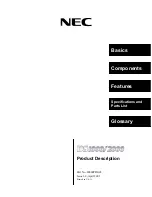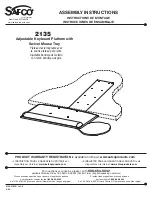
21
OPERATION
APPLICATIONS
You may use this tool for the purposes listed below:
Straight line cutting operations such as cross cutting,
ripping, mitering, beveling, and compound cutting
Dado or molding cuts with optional accessories
Cabinet making and woodworking
NOTE:
This table saw is designed to cut wood and wood
composition products only.
BASIC OPERATION OF THE TABLE SAW
The 3-prong plug must be plugged into a matching outlet
that is properly installed and grounded according to all local
codes and ordinances. Improper connection of the equipment
can result in electric shock. Check with an electrician or
service personnel if you are unsure about proper grounding.
Do not modify the plug; if it will not fit the outlet, have the
correct outlet installed by a qualified electrician. Refer to the
Electrical
section earlier in this manual.
CAUSES OF KICKBACK
Kickback can occur when the blade stalls or binds, kicking
the workpiece back toward you with great force and speed. If
your hands are near the saw blade, they may be jerked loose
from the workpiece and may contact the blade. Obviously,
kickback can cause serious injury, and it is well worth using
precautions to avoid the risks.
Kickback can be caused by any action that pinches the blade
in the wood, such as the following:
Making a cut with incorrect blade depth
Sawing into knots or nails in the workpiece
Twisting the wood while making a cut
Failing to support work
Forcing a cut
Cutting warped or wet lumber
Using the wrong blade for the type of cut
Not following correct operating procedures
Misusing the saw
Failing to use the anti-kickback pawls
Cutting with a dull, gummed-up, or improperly set
blade
AVOIDING KICKBACK
Always use the correct blade depth setting. The top of
the blade teeth should clear the workpiece by 1/8 in. to
1/4 in.
Inspect the work for knots or nails before beginning a
cut. Knock out any loose knots with a hammer. Never
saw into a loose knot or nail.
Always use the rip fence when rip cutting and the miter
gauge when cross cutting. This helps prevent twisting
the wood in the cut.
Always use clean, sharp, and properly-set blades. Never
make cuts with dull blades.
To avoid pinching the blade, support the work properly
before beginning a cut.
When making a cut, use steady, even pressure. Never
force cuts.
Do not cut wet or warped lumber.
Always hold your workpiece firmly with both hands or with
push sticks. Keep your body in a balanced position to
be ready to resist kickback should it occur. Never stand
directly in line with the blade.
Use the right type of blade for the cut being made.
CUTTING AIDS
See Figure 21.
Push sticks are devices used for safely pushing a workpiece
through the blade instead of using your hands. They can be
made in various sizes and shapes from scrap wood to use
in a specific project. The stick must be narrower than the
workpiece, with a 90° notch in one end and shaped for a
grip on the other end.
A push block has a handle fastened by recessed screws
from the underside. Be sure the screw is recessed. Use it
on non-through cuts.
CAUTION:
Be sure the screws in a push block are recessed
to avoid damaging the saw or workpiece.
Fig. 21
PUSH BLOCKS
PUSH STICKS
Summary of Contents for TS2400LS
Page 44: ...44 NOTES ...
















































